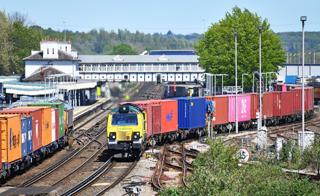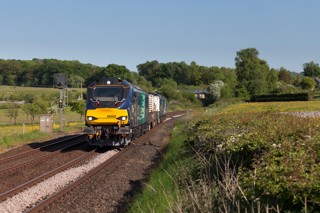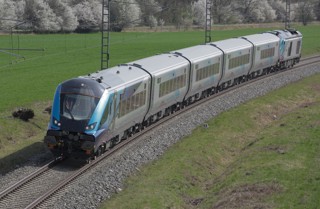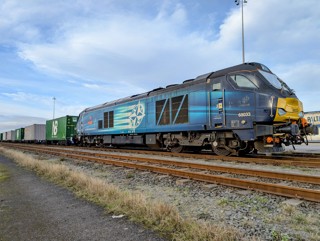The digital revolution
Guest Column by Andy Symonds, Business Development Consultant, CACI
Boosting efficiency and keeping staff and passengers safe
“If, thanks to greater automation, the rail sector can thrive in the future, this is likely to translate into more job opportunities than job losses. If, on the contrary, rail is overtaken by the pace of changes in other transport modes, there is no question about what that will mean for rail jobs.” Luisa Moisio, Director of Research and Development, Rail Safety and Standards Board (RSSB).
When the first steam trains appeared in the early 19th century, they were state-of-the-art technology and closely connected with the Industrial Revolution. Now, in the 21st century, the modernisation of the rail business is closely allied to the software revolution.
Digitisation and modernisation are generally thought of as having a negative effect on employment, but change can create jobs and enhance service delivery, with each employee contributing more effectively and efficiently.
More robust evidence-based oversight of the workforce enables organisations to identify where they need extra staff and to train their existing workforce. This helps to produce a better quality of work, resulting in more efficient service delivery.
However, some effort is needed. In April 2021, EU Employment Commissioner Nicolas Schmit said that while digitalisation of the rail sector will create ‘quality jobs’ for rail workers, new technology means upskilling will be required.
While this would appear self-evident, matching demand to skills, efficient scheduling and service depend on an adaptable workforce equipped with both accurate information in real-time and the ability to record, assess and respond quickly to incidents and short-term changes. Additionally, there is the need for the right user-friendly software to fit the requirements and ability of staff collectively and individually.
The wellbeing of rail passengers is largely dependent on the wellbeing of staff. Aspects of working practice, such as those relating to fatigue, are essential to the service that rail companies provide. Therefore, a system in which digitalisation is intrinsic offers the best means to achieve a highly efficient and safe service.
The functioning of rail services can be made safer and more efficient by proper scheduling, fatigue management and rostering, facilitated by software. Business rules can be built into software to automatically produce a roster for staff which ensures they are working within the parameters of their contracts - for example, not exceeding any safe level of hours to work.
Management and fatigue
Unobtrusive but effective and systemic management can be achieved using digital processes. The invisible manager never sleeps and never forgets or overlooks anything of relevance.
Management also needs to be aware that aspects such as fatigue can be subjective. They need to be supportive of this and provide staff with the ability to self-report on situations where they suffer from fatigue without any repercussions. Reports can thus be generated and trends leading to fatigue can be easily identified.
According to RSSB, 20% of high-risk accidents on the railway are the result of fatigue. But fatigue can be prevented by technology systems, regular assessment of shift patterns, and ensuring that staff are adequately rested before undertaking safety-critical work.
This can be addressed through proper rostering. Balanced, responsible and responsive application of rostering and competency management can reduce fatigue, inefficiencies and their effects on safety.
Manual record-keeping and spreadsheets means that a proper overview is difficult to achieve and mistakes become possible, risking safety. A holistic view of shift patterns and skill sets is achievable with the right software tools, enabling timely performance of tasks, proper record-keeping of shifts, plus overtime and shift swaps - in tune with fatigue management protocols as well as efficiency.
An overview and specific identification of the qualifications and skills of the workforce in relation to tasks and job specifications is also very important.
The rail industry, its staff and customers are best served by a swift implementation of the right digital solutions.
Single source of truth
The safety of rail workers and passengers can depend on more than one factor and more than one operator. The need for adequate records prompting action was highlighted by a fatal accident that occurred on December 1 2018, when a passenger was hit by the branch of a tree while leaning out of the window of a train travelling at 75mph.
The Rail Accident Investigation Branch investigated the tragedy and identified several errors across two operating companies that contributed in various ways to the accident - from inadequate signage and omission of inspection to a failure to highlight work that remained outstanding. These could all perhaps have been prevented by automation of the record-keeping process and adequate relevant staff training in its use.
The automation of processes and procedures such as data gathering, training, and recording incidents and procedure, makes data mapping and understanding the root causes of incidents much more straightforward.
Transforming today for a better tomorrow
Digital workforce management solutions to transform and sustain efficient business practice for the rail sector are available now. Configurable and user-friendly software to support and automate your company-specific requirements helps to reduce operational risk and ensure tasks are conducted compliantly.
Technology can help rail organisations to auto-schedule shift patterns and assess staff competencies, to ensure rostered staff are given adequate rest periods before undertaking safety-critical tasks. This includes the ability to record travel time to and from a job, which has been shown to be a key fatigue factor in incidents. This can be enhanced by allowing staff to remotely record the information in real time.
Given that no two organisations are the same, it is vital that your business rules and processes can be catered for. A good system will facilitate this, helping you to adapt to the inevitable changes that will occur across your workforce and your processes over time. Change is one constant that we all face, so being agile makes adapting much more straightforward.
The way forward
Failure to take full advantage of technology not only risks the rail industry being left behind and degenerating, compared with other more progressive modes of transport, it also risks the day-to-day wellbeing and lives of the workforce as much as their livelihoods. All of this affects the safety of (and efficient service to) rail customers.
A robust software solution can help you to keep on top of all workforce concerns, keep projects moving, and help with keeping to timetables and agreed service delivery.
Relying on manual processes and spreadsheets exposes your scheduling and workforce management to considerable risk and human error. Create efficiency, improve safety and upskill your workforce - there has never been a better time to understand how software solutions can help.
About the author
Andy Symonds is Business Development Consultant at CACI Ltd, providing expertise on Workforce Management and Scheduling solutions. He has been working in the Public Sector for over 20 years and has considerable experience in both procurement processes and managing Public Sector accounts.


















Login to comment
Comments
No comments have been made yet.